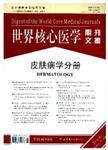葡糖胺、硫酸软骨素及二者联合使用治疗痛性膝关节炎
Glucosamine, chondroitin sulfate, and the two in combination for painful knee osteoarthritis作者机构:University of Utah Division of Rheumatology 4B200 School of Medicine 50 N. Medical Dr. Salt Lake City UT 84132 United States Dr.
出 版 物:《世界核心医学期刊文摘(神经病学分册)》 (Digest of the World Core Medical Journals.Clinical Neurology)
年 卷 期:2006年第8期
页 面:1-2页
学科分类:1002[医学-临床医学] 100210[医学-外科学(含:普外、骨外、泌尿外、胸心外、神外、整形、烧伤、野战外)] 10[医学]
摘 要:Background: Glucosamine and chondroitin sulfate are used to treat osteoarthritis. The multicenter, double- blind, placebo- and celecoxib- controlled Glucosamine/chondroitin Arthritis Intervention Trial (GAIT) evaluated their efficacy and safety as a treatment for knee pain from osteoarthritis. Methods: We randomly assigned 1583 patients with symptomatic knee osteoarthritis to receive 1500 mg of glucosamine daily, 1200 mg of chondroitin sulfate daily, both glucosamine and chondroitin sulfate, 200 mg of celecoxib daily, or placebo for 24 weeks. Up to 4000 mg of acetaminophen daily was allowed as rescue analgesia. Assignment was stratified according to the severity of knee pain (mild [N = 1229] vs. moderate to severe [N = 354]). The primary outcome measure was a 20 percent decrease in knee pain from baseline to week 24. Results: The mean age of the patients was 59 years, and 64 percent were women. Overall, glucosamine and chondroitin sulfate were not significantly better than placebo in reducing knee pain by 20 percent. As compared with the rate of response to placebo (60.1 percent), the rate of response to glucosamine was 3.9 percentage points higher (P = 0.30), the rate of response to chondroitin sulfate was 5.3 percentage points higher (P = 0.17), and the rate of response to combined treatment was 6.5 percentage points higher (P = 0.09). The rate of response in the celecoxib control group was 10.0 percentage points higher than that in the placebo control group (P = 0.008). For patients with moderate- to- severe pain at baseline, the rate of response was significantly higher with combined therapy than with placebo (79.2 percent vs. 54.3 percent, P = 0.002). Adverse events were mild, infrequent, and evenly distributed among the groups. Conclusions: Glucosamine and chondroitin sulfate alone or in combination did not reduce pain effectively in the overall group of patients with osteoarthritis of the knee. Exploratory analyses suggest that the combination of glucosamine



